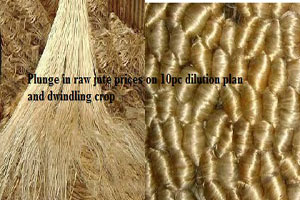
Plunge in raw jute prices on 10pc dilution plan and dwindling crop
YarnsandFibers News Bureau 2017-02-09 15:00:00 – BhubaneswarWith the Union textiles ministry’s plan to go for 10 percent dilution of the mandatory jute packaging order for food grains amid projected shortfall of 0.17 million bales (one bale is 180 kg) of B Twill jute bags during the rabi marketing season 2016-17 and dwindling crop supplies triggered by demonetization, the prices of raw jute are on downward trend.
The Jute 1 Packaging Materials Act, 1987, mandates 100 per cent use of jute bags for packaging of food grains meant for government procurement
The raw jute prices have tanked to Rs 36,650 per tonne in February this year from Rs 56,520 per tonne in July 2016 and are likely to plunge further. In 2015-16, there was an unabated rise in prices of raw jute.
The downtrend in prices could dissuade farmers from growing more jute in the 2017-18 sowing season, said a mill owner.
The shortfall in B T sacking bags will be offset by the use of high density polyethylene (HDPE) and polypropylene (PP) bags.
The combined effect of demonetisation and the government opting for plastic bags to meet the food grains requirement for the rabi marketing season has come as a double blow to the jute industry. The impact is already showing in softening prices of raw jute.
Raghavendra Gupta, chairman of the Indian Jute Mills' Association (IJMA), could not be reached for comments. Later, the ministry gave further permission for use of 0.32 million bales of plastic bags to cater to packaging requirement of the RMS.
Public sector firm Jute Corporation of India (JCI) has so far procured 0.22 million bales. JCI is continuing with its purchase since lower-grade jute (TD-6 and below) raised in Nadia and Murshidabad in West Bengal and parts of Bihar are available at MSP (minimum support price) rates.
Further, MSP grade differences are comparatively lower to ruling market prices. This may enable JCI to achieve its initial procurement target of 0.45 million bales during this financial year.
Though JCI’s procurement operations is expected to stabilise the prices and arrest falling tendencies, majority quantity purchases will be of TD-6 and lower grades which have least scope of being used in the laid down batch mix of finished goods. This apart, the low-grade varieties of raw jute have least use in manufacturing diversified jute products for which there is mounting pressure from the government.
Raw jute crop size during the 2016-17 season is estimated at 9.5 million bales. However, only 65 per cent of the production has arrived so far in the market.
Market Intelligence
Ask for free sample Report

experience
Customer Base
dedicated team
Countries Served Worldwide









